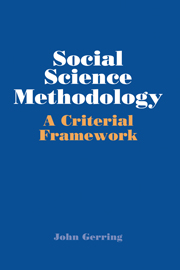Book contents
10 - Strategies of Research Design
Published online by Cambridge University Press: 05 June 2012
Summary
I shall distinguish sharply between the process of conceiving a new idea, and the methods and results of examining it logically… [With respect to the latter,] certain singular statements – which we may call “predictions” – are deduced from the theory; especially predictions that are easily testable or applicable. From among these statements, those are selected which are not derivable from the current theory, and more especially those which the current theory contradicts. Next we seek a decision as regards these (and other) derived statements by comparing them with the results of practical applications and experiments. If this decision is positive, that is, if the singular conclusions turn out to be acceptable, or verified, then the theory has, for the time being, passed its test: we have found no reason to discard it. But if the decision is negative, or in other words, if the conclusions have been falsified, then their falsification also falsifies the theory from which they were logically deduced.
–Karl PopperOur discussion of research design has ranged from general criteria (Chapter 8) to particular methods (Chapter 9). This final chapter takes up general considerations of strategy. How should we formulate and test our propositions and what, specifically, should be the relationship between theory and evidence?
According to one view, exemplified by Karl Popper, the best test of an empirical proposition is provided when the acts of theory generation and theory testing are segregated in time and space, so that the analyst is prevented from adjusting her favored explanation to suit the facts of a given case.
- Type
- Chapter
- Information
- Social Science MethodologyA Criterial Framework, pp. 230 - 243Publisher: Cambridge University PressPrint publication year: 2001



